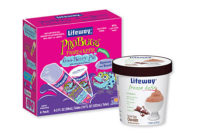Creating the next generation of cheeses
By combining food science and nutritional research, next-generation cheese products could have greater appeal

Cheese is a very interesting food from a nutritional perspective. It typically is low in carbohydrates (or has none), is high in protein and is rich in key vitamins and minerals such as calcium and phosphorous. As a fermented food, cheese also can contain components such as probiotics (beneficial bacteria) and bioactive peptides, both of which have potentially exciting health impacts.
Unfortunately, many people do not understand that cheeses, especially aged cheeses, also contain little to no lactose since they are fermented by the starter culture and other bacteria. The dairy industry would greatly benefit from an educational campaign touting cheese as a good choice for those who have difficulty digesting lactose. Additionally, aged cheeses, in which the milk proteins are substantially broken down, should be tolerated better by people with milk protein allergies.
Cheese’s relatively high fat and protein contents, as well as its low carbohydrate content, also make it attractive for those following an Atkins or ketogenic diet. And since cheese comes in numerous textures and tastes, there are plenty of delicious options from which to choose.
Nutritional benefits
We’re currently learning some exciting new things about bioactive peptides, which are created during the ripening of cheese when some of the proteins are broken down. These peptides have some physiological impacts on the body. For instance, some bioactive peptides are anti-hypertensive, which means they reduce blood pressure. Perhaps we could add or boost the levels of certain peptides in cheese to provide additional health benefits.
In recent years, nutritional research has been changing its view of full-fat dairy products. Studies are walking back previous ideas that consumption of dairy fat might increase certain health risks that contribute to cardiovascular disease (CVD). Dairy product consumption has also been associated with positive health benefits for other serious issues such as diabetes and obesity. Fermented dairy products, including cheese, are often considered to have a positive effect on CVD outcomes. Full-fat dairy foods (including whole milk and full-fat yogurt) are growing in popularity again due to their excellent taste and textural properties.
Changing food structure
A growing number of scientists are also realizing that we should assess the structure — or “food matrix” — of our food rather than focusing on a single nutrient when trying to evaluate the impact of a specific food on health outcomes. The challenge is that complex foods such as cheese contain many different nutrients combined in a physical structure (matrix) that impacts digestion (including the kinetics or rate of digestion) and absorption of nutrients. Food scientists are looking at how they can alter the food matrix to modify the digestibility and accessibility of nutrients.
There are many approaches that could be used to alter the structure of cheese. These early findings are exciting because as we learn more about how the structure of cheese impacts digestion, we could potentially make cheese with a matrix that promotes digestion and absorption of certain key nutrients.
Didier Dupont of the French National Institute for Agricultural Research indicated in a recent review that altering dairy matrices could be of great interest for the development of innovative dairy products for specific age groups — such as the older population — and cheeses could be designed so that they would have optimized metabolic effects when consumed.
It’s an exciting area that could change how we manufacture cheese in the future. Instead of using recipes to create a specific texture/flavor, we may try to manipulate the way that cheese is digested. Combining innovative food science and nutritional research could help provide next-generation cheese products targeted for the health and wellness sector.
Looking for a reprint of this article?
From high-res PDFs to custom plaques, order your copy today!









